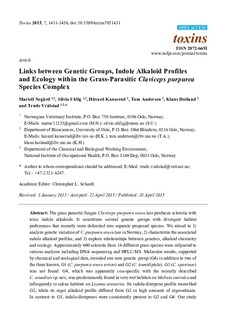| dc.description.abstract | The grass parasitic fungus Claviceps purpurea sensu lato produces sclerotia with toxic indole alkaloids. It constitutes several genetic groups with divergent habitat preferences that recently were delimited into separate proposed species. We aimed to 1) analyze genetic variation of C. purpurea sensu lato in Norway, 2) characterize the associated indole alkaloid profiles, and 3) explore relationships between genetics, alkaloid chemistry and ecology. Approximately 600 sclerotia from 14 different grass species were subjected to various analyses including DNA sequencing and HPLC-MS. Molecular results, supported by chemical and ecological data, revealed one new genetic group (G4) in addition to two of the three known; G1 (C. purpurea sensu stricto) and G2 (C. humidiphila). G3 (C. spartinae) was not found. G4, which was apparently con-specific with the recently described C. arundinis sp. nov, was predominantly found in very wet habitats on Molinia caerulea and infrequently in saline habitats on Leymus arenarius. Its indole-diterpene profile resembled G2, while its ergot alkaloid profile differed from G2 in high amounts of ergosedmam. In contrast to G1, indole-diterpenes were consistently present in G2 and G4. Our study supports and complements the newly proposed species delimitation of the C. purpurea complex, but challenges some species characteristics including host spectrum, habitat preferences and sclerotial floating ability. | |
